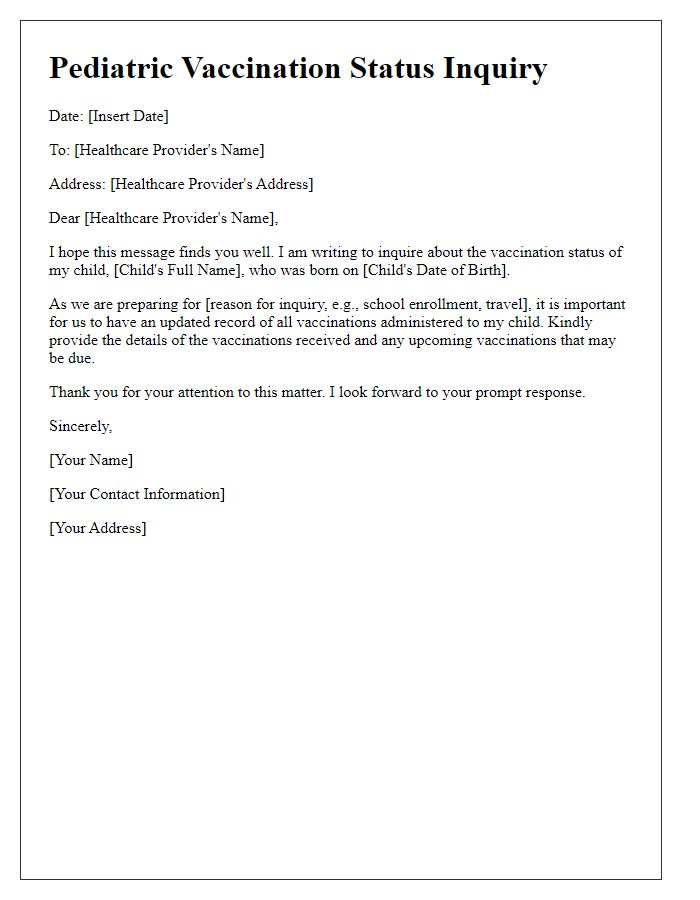Are you looking for a simple way to keep track of your child's immunizations? A pediatric immunization checklist is a fantastic tool that ensures your little one stays up-to-date with their vaccinations. Not only does it help you remember important dates, but it also empowers you to have meaningful conversations with your pediatrician. Let's dive into how to create your own checklist and why it's essential for your child's healthâread on to find out more!

Child's Name and Date of Birth
The pediatric immunization checklist for a child, typically requires crucial information such as the child's full name, for identifying the individual, and the date of birth, for determining age-specific vaccination requirements. Immunization records often include vaccines like the DTaP (Diphtheria, Tetanus, and Pertussis), administered in multiple doses beginning at 2 months of age, and the MMR (Measles, Mumps, and Rubella) vaccine, usually given between 12 to 15 months. Parents or guardians are encouraged to check with healthcare providers to ensure that all recommended vaccinations are completed on schedule, following the guidelines established by the Centers for Disease Control and Prevention (CDC).
Vaccine Type and Schedule
Pediatric immunization checklists are essential for ensuring that children receive timely vaccinations, which protect them against various preventable diseases. The checklist typically includes vaccines such as DTaP (Diphtheria, Tetanus, and Pertussis) administered in a series of five doses, beginning at two months of age. The MMR vaccine (Measles, Mumps, Rubella) is usually given at twelve months, followed by a booster dose at four to six years. The varicella vaccine, essential for preventing chickenpox, is also administered around twelve months and again at four to six years of age. Additionally, the hepatitis B vaccine, which protects against a viral infection that can lead to liver disease, is provided in three doses, starting at birth. Other vaccines, including the PCV13 (Pneumococcal conjugate vaccine) and the IPV (Inactivated poliovirus vaccine), complete the immunization schedule, which is critical for maintaining public health and preventing outbreaks. Regular monitoring and adherence to local health guidelines ensure that each child's immunization status remains up-to-date.
Healthcare Provider Contact Information
Pediatric immunization checklists serve as crucial tools for parents to ensure their children receive necessary vaccines to protect against infectious diseases. Key contact information for healthcare providers includes the clinic's name, address, phone number, and email address, enabling easy communication for vaccination appointments or inquiries. Essential vaccines like DTaP (Diphtheria, Tetanus, Pertussis), MMR (Measles, Mumps, Rubella), and IPV (Inactivated Poliovirus) should be clearly listed with corresponding recommended ages for administration, typically ranging from infancy to four years old. Notable health guidelines, including those from the Centers for Disease Control and Prevention (CDC), emphasize the importance of adhering to the immunization schedule to enhance community immunity and prevent outbreaks of vaccine-preventable diseases.
Follow-Up Appointment Dates
Pediatric immunization scheduling requires careful attention to follow-up appointment dates to ensure children receive essential vaccines at the appropriate intervals. Vaccines such as DTaP (Diphtheria, Tetanus, and Pertussis) and MMR (Measles, Mumps, and Rubella) typically demand multiple doses within specific time frames, usually spaced out by weeks or months (for instance, the second DTaP dose is generally administered at 4 months). Parents must maintain an organized calendar to track upcoming appointments, often set within a pediatric practice like Children's Hospital of Philadelphia. Additionally, discussion of vaccination side effects during follow-up visits is crucial for child health education. Accessing immunization records at facilities such as the CDC can help monitor compliance with vaccine schedules, ensuring children meet state requirements for school enrollment, especially in states with strict immunization laws.
Parental/Guardian Consent and Signature
The pediatric immunization checklist serves as a crucial document for tracking required vaccinations for children, ensuring adherence to health guidelines. This checklist includes essential vaccine names, such as Measles, Mumps, and Rubella (MMR), Diphtheria, Tetanus, and Pertussis (DTaP), and Varicella (chickenpox). Each vaccine entry indicates specific age requirements as per the Centers for Disease Control and Prevention (CDC) schedule, usually ranging from birth to age 18. The checklist also outlines potential side effects, dosage information, and the significance of maintaining the recommended vaccination timeline to promote herd immunity. A section dedicated to parental or guardian consent captures signatures and important contact information, reinforcing the role of caregivers in the immunization process. This structured approach supports public health initiatives aimed at preventing outbreaks of vaccine-preventable diseases.













Comments